Top Rankings
Lewis Central Comm School District ranks among the top 20% of public school district in Iowa for:
Category
Attribute
Graduation Rate
Highest graduation rate (Top 5%)
Community Size
Largest student body (number of students) (Top 1%)
For the 2025 school year, there is 1 public middle school serving 730 students in Lewis Central Comm School District. This district's average middle testing ranking is 6/10, which is in the top 50% of public middle schools in Iowa.
Public Middle School in Lewis Central Comm School District have an average math proficiency score of 62% (versus the Iowa public middle school average of 64%), and reading proficiency score of 80% (versus the 71% statewide average).
Minority enrollment is 22% of the student body (majority Hispanic), which is less than the Iowa public middle school average of 25% (majority Hispanic).
Overview
This School District
This State (IA)
# Schools
4 Schools
376 Schools
# Students
3,146 Students
127,807 Students
# Teachers
190 Teachers
8,868 Teachers
Student : Teacher Ratio
17:1
17:1
District Rank
Lewis Central Comm School District, which is ranked within the top 50% of all 325 school districts in Iowa (based off of combined math and reading proficiency testing data) for the 2021-2022 school year.
The school district's graduation rate of 96% has increased from 93% over five school years.
Overall District Rank
#158 out of 327 school districts
(Top 50%)
(Top 50%)
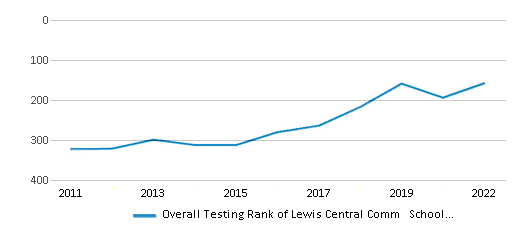
Math Test Scores (% Proficient)
66%
64%
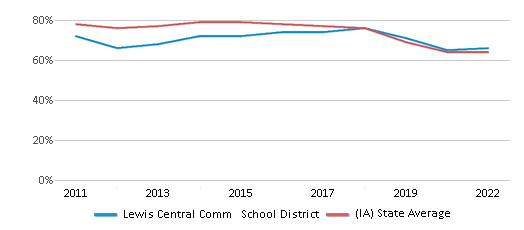
Reading/Language Arts Test Scores (% Proficient)
74%
70%
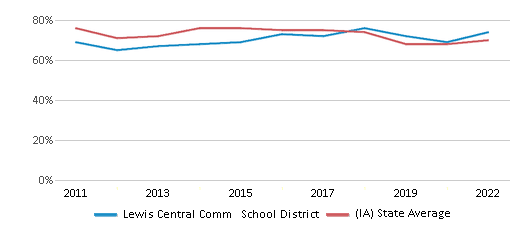
Science Test Scores (% Proficient)
64%
63%
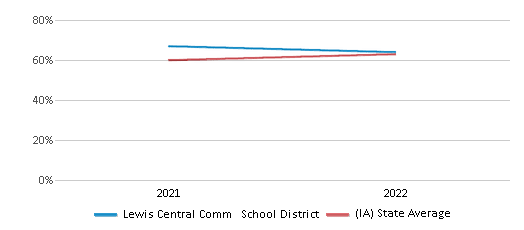
Graduation Rate
96%
90%
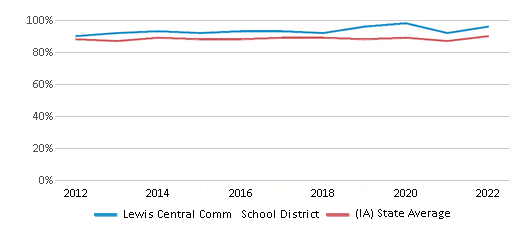
Students by Ethnicity:
Diversity Score
0.35
0.43
# American Indian Students
6 Students
711 Students
% American Indian Students
n/a
n/a
# Asian Students
23 Students
2,758 Students
% Asian Students
1%
2%
# Hispanic Students
387 Students
14,712 Students
% Hispanic Students
12%
11%
# Black Students
53 Students
7,560 Students
% Black Students
2%
6%
# White Students
2,514 Students
95,300 Students
% White Students
80%
75%
# Hawaiian Students
2 Students
746 Students
% Hawaiian Students
n/a
1%
# Two or more races Students
161 Students
5,934 Students
% of Two or more races Students
5%
5%
Students by Grade:
# Students in PK Grade:
77
157
# Students in K Grade:
228
170
# Students in 1st Grade:
199
177
# Students in 2nd Grade:
229
171
# Students in 3rd Grade:
219
167
# Students in 4th Grade:
231
559
# Students in 5th Grade:
231
5,544
# Students in 6th Grade:
234
24,308
# Students in 7th Grade:
229
36,022
# Students in 8th Grade:
267
37,018
# Students in 9th Grade:
275
8,339
# Students in 10th Grade:
251
5,155
# Students in 11th Grade:
221
5,047
# Students in 12th Grade:
255
4,973
# Ungraded Students:
-
-
District Revenue and Spending
The revenue/student of $14,289 in this school district is less than the state median of $16,468. The school district revenue/student has declined by 5% over four school years.
The school district's spending/student of $15,477 is less than the state median of $16,042. The school district spending/student has declined by 5% over four school years.
Total Revenue
$45 MM
$8,262 MM

Spending
$49 MM
$8,048 MM

Revenue / Student
$14,289
$16,468
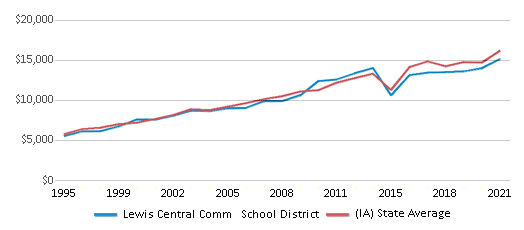
Spending / Student
$15,477
$16,042

Best Lewis Central Comm School District Public Middle Schools (2025)
School
(Math and Reading Proficiency)
(Math and Reading Proficiency)
Location
Grades
Students
Rank: #11.
Lewis Central Middle School
(Math: 62% | Reading: 80%)
Rank:
Rank:
6/
Top 50%10
3820 Harry Langdon Blvd.
Council Bluffs, IA 51503
(712) 366-8252
Council Bluffs, IA 51503
(712) 366-8252
Grades: 6-8
| 730 students
Recent Articles

Year-Round Or Traditional Schedule?
Which is more appropriate for your child? A year-round attendance schedule or traditional schedule? We look at the pros and cons.

Why You Should Encourage Your Child to Join a Sports Team
Participating in team sports has a great many benefits for children, there is no doubt. In this article you will learn what those benefits are.

White Students are Now the Minority in U.S. Public Schools
Increasing birth rates among immigrant families from Asia and Central and South America, combined with lower birth rates among white families, means that for the first time in history, public school students in the United States are majority-minority. This shift in demographics poses difficulties for schools as they work to accommodate children of varying language abilities and socio-economic backgrounds.





